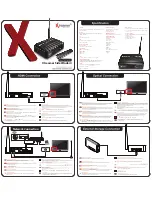
7
RNG110 OPERATOR’S MANUAL (501-3438000)
WARNINGS
Do not connect your set-top (or
any other equipment such as a TV
or VCR) to the power supply until
you have properly connected all the
other cables.
Disconnect your set-top’s power
supply unit from the AC power
supply before you disconnect any
other equipment from its rear panel.
The only way to disconnect your
set-top from the AC power supply
is to remove the power supply unit
from the wall AC outlet (or switch
the wall AC outlet switch, if present,
to its OFF position). Your set-top
must therefore be installed near to
the wall AC outlet, which should be
easily accessible.
The cable input is designed for
connection to a cable network only.
You must not connect any other
equipment, such as a VCR, to this
input.
In order for you to view programs broadcast in high-definition, your set-top must be connected to a suitable
HDTV or computer monitor. Your set-top is also compatible with standard-definition TVs and VCRs.
Your equipment should have been connected up by your installer. However, if you need to disconnect and re-
connect your equipment, read this page and page 8.
There are two typical connection setups for an HDTV, VCR, DVD player, and home theater receiver.
These setups make efficient use of the connectors on your set-top. However, depending on your other
equipment and the connectors on it, the person who installed your system may have chosen to connect things
up differently.
Both setups allow stereo recording and play-back of video tapes. You hear stereo sound from the home
theater’s loudspeakers.
You can take advantage of the digital audio output from your set-top by connecting a suitable cable between
your home theater receiver and the OPTICAL AUDIO OUT connector (as shown in the diagrams).
CONNECTING THE EQUIPMENT
Setup A - Home theater system with HDTV
(HDMI connection)
Setup A uses an HDMI connector to connect to the HDTV. This displays the highest quality picture on the
HDTV and also means there will be no picture degradation on any copy-protected programs (provided the link
remains secure – see page 6).
ANTENNA/
RF IN
TV / RF
OUT
ANTENNA/
RF IN
LEFT
AUDIO IN
RIGHT
AUDIO IN
VIDEO IN
LEFT
AUDIO IN
RIGHT
AUDIO IN
VIDEO IN
POWER
LEFT
AUDIO OUT
RIGHT
AUDIO OUT
VIDEO OUT
CABLE INPUT
HDTV
VCR
DVD
LEFT
AUDIO IN
VCR IN
RIGHT
AUDIO IN
VIDEO IN
PB/CB
PR/CR
Y
COMPONENT
VIDEO OUT
HOME THEATER RECEIVER
OPTICAL
AUDIO IN
COAXIAL
AUDIO IN
DIGITAL AUDIO OUT
DIGITAL AUDIO IN
OPTICAL
COAXIAL
PB/CB IN
PR/CR IN
Y IN
COMPONENT
VIDEO IN
POWER
POWER
POWER
HDMI
WALL AC OUTLET
WALL AC OUTLET
WALL AC
OUTLETS
NOTE
This diagram shows a video path
from the set-top to a VCR to allow
recording by the VCR. It shows a
video path from the VCR to the TV
to allow playback of videos. Video
signals fed through a VCR may be
affected by copyright protection
systems, which can cause picture
distortion on your TV.
Do not, therefore, use a path
through a VCR to watch your
set-top programs. Use the HDMI
path or an alternate direct video
path from your set-top to your
TV. Remember to select the
correct input on your TV.
NOTES
How you set up your equipment may depend on your home theater receiver. For example, the optical audio input
may be associated with a particular video input. Consult your home theater user guide for further details.





























